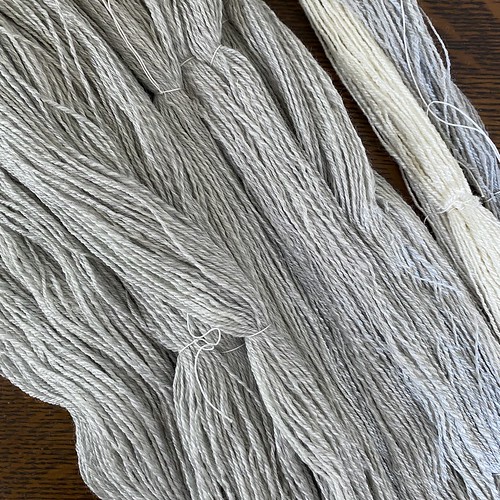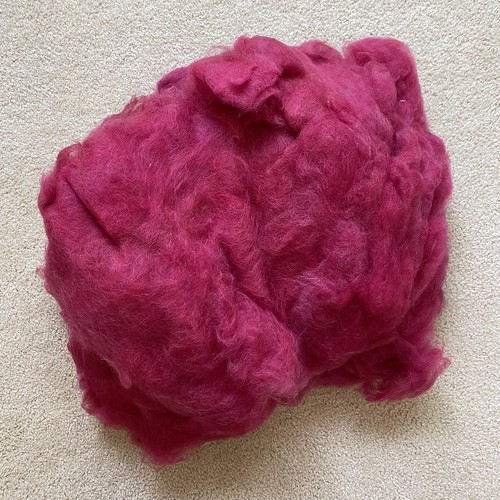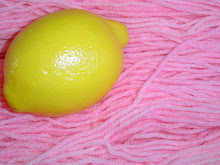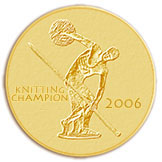Spinning
The Winter Solstice spinning has been skeined and washed! I wish everyone could squeeze this yarn; it's so squishy and soft and drapey, but that would probably just make the Internet even weirder. I ended up with 1,417 yards of a heavy fingering weight three ply, plus I have 84 yards and 43 yards of natural and gray chain plied yarn (respectively) from what was left on the bobbins. When you spin a three ply yarn eventually you get down to two bobbins of singles as you're plying, no matter how many bobbins you started out with. Since my main yarn had two plies of gray and one ply of undyed, natural white wool there was no way to make a chain plied yarn that was similar, so I divided the colors and made two chain plied mini skeins. The chain plied skeins are visible in the upper right corner of the photo above. I already have a sweater idea for the main yarn. The chain plied skeins will be tossed in with other chain plied leftovers from other spinning projects and used for something later. No clue what that will be.
Once I emptied my spinning wheel bobbins it was time to fill them up again, so I started my next spinning project. This is some deep stash wool, purchased in 2007 at MDS&W (probably the last time I went to MDS&W). I believe it's from Spinner's Hill. It's mostly wool, but I've also seen something that looks like it might be kid mohair. I found a blog post where I mentioned buying it but it makes no mention of what the fiber content is, only a pound and a half of fiber from Spinner's Hill. The color is a deep raspberry. It's kind of where red turns into hot pink or where hot pink turns into red, depending on which direction you're going. It's definitely on the cool side of the red part of the color wheel.
For those of who don't spin, you might be thinking this fiber looks very different from my previous spinning fiber photos. This is a batt. What you've seen here lately has been commercial top which looks like thick, fluffy rope. If you were to look closely at the two different fiber preparations, you would see that the individual fibers in the top are all laying next to each other and oriented perfectly parallel. This makes for a dense, smooth yarn that tend to have a bit of shine, depending on what type of wool is used. In a batt the individual fibers are all going different directions - like they're having a party. Yarns spun from a batt will be more airy and fluffy because of this and will also have less shine because the surface of the yarn isn't smooth, and therefore can't reflect light like it could if the fibers were parallel. This is a basic explanation and using different spinning techniques can change the properties of the finished yarn beyond what the specific preparation does, but that's another blog post for another day.
I've found a possible sweater idea for this and I'm spinning this to be a three ply, hopefully sportweight yarn. My previously spun yarns have lately been fingering weight so I've got to spin the singles a tiny bit thicker, but because of the prep (batt vs. top) the finished yarn will bloom more than previous yarns so I don't want to go too much thicker. I did a bit of sampling and I'm working carefully so I don't just start autopilot spinning and make the singles too thin. I'll spin six bobbins of singles from this fiber before I start plying. I've set up the wheel (Schacht Flatiron) with Scotch Tension and I'm using a ratio of 8.5:1. The jumbled nature of the batt means I don't need as much twist to hold the fiber together as in previous projects.
Once I emptied my spinning wheel bobbins it was time to fill them up again, so I started my next spinning project. This is some deep stash wool, purchased in 2007 at MDS&W (probably the last time I went to MDS&W). I believe it's from Spinner's Hill. It's mostly wool, but I've also seen something that looks like it might be kid mohair. I found a blog post where I mentioned buying it but it makes no mention of what the fiber content is, only a pound and a half of fiber from Spinner's Hill. The color is a deep raspberry. It's kind of where red turns into hot pink or where hot pink turns into red, depending on which direction you're going. It's definitely on the cool side of the red part of the color wheel.
For those of who don't spin, you might be thinking this fiber looks very different from my previous spinning fiber photos. This is a batt. What you've seen here lately has been commercial top which looks like thick, fluffy rope. If you were to look closely at the two different fiber preparations, you would see that the individual fibers in the top are all laying next to each other and oriented perfectly parallel. This makes for a dense, smooth yarn that tend to have a bit of shine, depending on what type of wool is used. In a batt the individual fibers are all going different directions - like they're having a party. Yarns spun from a batt will be more airy and fluffy because of this and will also have less shine because the surface of the yarn isn't smooth, and therefore can't reflect light like it could if the fibers were parallel. This is a basic explanation and using different spinning techniques can change the properties of the finished yarn beyond what the specific preparation does, but that's another blog post for another day.
I've found a possible sweater idea for this and I'm spinning this to be a three ply, hopefully sportweight yarn. My previously spun yarns have lately been fingering weight so I've got to spin the singles a tiny bit thicker, but because of the prep (batt vs. top) the finished yarn will bloom more than previous yarns so I don't want to go too much thicker. I did a bit of sampling and I'm working carefully so I don't just start autopilot spinning and make the singles too thin. I'll spin six bobbins of singles from this fiber before I start plying. I've set up the wheel (Schacht Flatiron) with Scotch Tension and I'm using a ratio of 8.5:1. The jumbled nature of the batt means I don't need as much twist to hold the fiber together as in previous projects.
Labels: spinning













1 Comments:
When you spin a batt, do you spin from the fold?
Post a Comment
<< Home